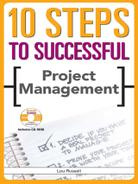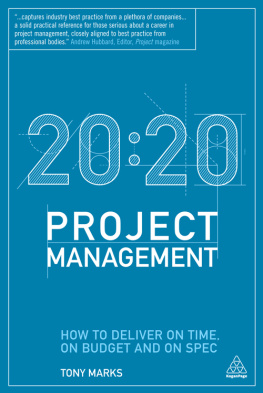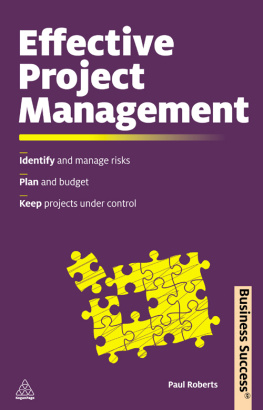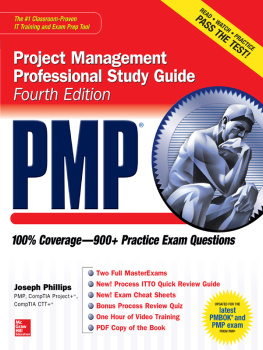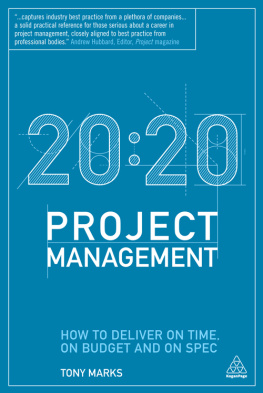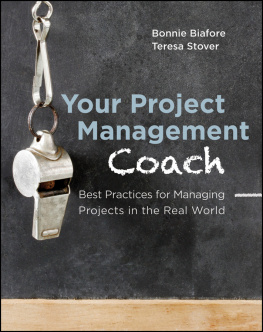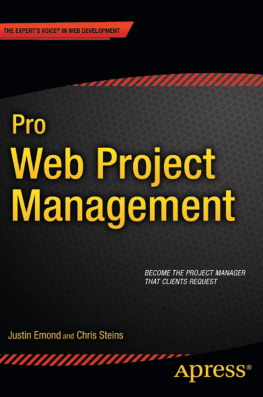10 STEPS TO
Successful
Project
Management

Lou Russell

April 2007 by the American Society for Training & Development.
All rights reserved.
No part of this publication may be reproduced, distributed, or transmitted in any form or by any means, including photocopying, recording, or other electronic or mechanical methods, without the prior written permission of the publisher, except in the case of brief quotations embodied in critical reviews and certain other noncommercial uses permitted by copyright law. For permission requests, please refer to the Rights & Permissions section on the ASTD Online Store website at store.astd.org or write to ASTD Rights & Permissions, Publications Department, Box 1443, Alexandria, VA 22313-1443.
ASTD Press is an internationally renowned source of insightful and practical information on workplace learning and performance topics, including training basics, evaluation and return-on-investment (ROI), instructional systems development (ISD), e-learning, leadership, and career development.
Ordering information for print edition: Books published by ASTD Press can be purchased by visiting ASTD's website at store.astd.org or by calling 800.628.2783 or 703.683.8100.
Library of Congress Control Number: 2007937426
Print edition ISBN: 978-1-56286-463-7
PDF eBook edition ISBN: 978-1-60728-447-5
2007-1
ASTD Press Editorial Staff
Director: Cat Russo
Manager, Acquisitions & Author Relations: Mark Morrow
Editorial Manager: Jacqueline Edlund-Braun
Editorial Assistant: Kelly Norris
Copyeditor: Christine Cotting
Indexer: April Davis
Proofreader: Kris Patenaude
Interior Design and Production: UpperCase Publication Services, Ltd.
Cover Design: Renita Wade
10 STEPS TO SUCCESS
Let's face it, most people spend their days in chaotic, fast-paced, time-and resource-strained organizations. Finding time for just one more project, assignment, or even learning opportunityno matter how career enhancing or usefulis difficult to imagine. The 10 Steps series is designed for today's busy professional who needs advice and guidance on a wide array of topics ranging from project management to people management, from business planning strategy to decision making and time management, from return-on-investment to conducting organizational surveys and questionnaires. Each book in this ASTD series promises to take its readers on a journey to basic understanding, with practical application the ultimate destination. This is truly a just-tell-me-what-to-do-now series. You will find action-driven language teamed with examples, worksheets, case studies, and tools to help you quickly implement the right steps and chart a path to your own success. The 10 Steps series will appeal to a broad business audience from middle managers to upper-level management. Workplace learning and human resource professionals along with other professionals seeking to improve their value proposition in their organizations will find these books a great resource.
PREFACE
Like yours, my business life and my personal life have been very chaotic this year. Ironically, I have been writing this project management book, offering others advice about how to juggle all the projects in their lives while I haven't been doing a very good juggling job myself. I love teaching project management, and this, my third book on the topic, has enabled me to do what I love and has helped me get my own project management back where it should be. I hope it will be helpful to you in the same way.
I work in the real world. Academic project management is a nice starting place, but not enough for the complexity of the things that I want to manage. As I speak, the dog is scratching the door and my husband is rewiring the stereo system at full volume in the family room. My teenager's boyfriend will be here any minute and then we're all off to church later this evening. One daughter wants me to look at the IKEA website and help her (with my credit card) redesign her room. The other daughter wants me to help her load CDs on her new Chocolate cell phone. It's the week after Christmas, and the decorations are piled in the hall, near a foothill of laundry. Been here?
Professionally, my 20-year-old consulting company, Russell Martin & Associates, has been redefined at least 20 times. Right now, project management is critical to our ability to survive and grow. Like you, I didn't have time to do anything else, especially write a book. Sales were slow last year and we were scrambling to evolve our marketing strategy and product focus. Around this time, I heard David Norton speak. He shared this statistic: less than 10 percent of all companies successfully implement their strategies. I was convinced that if we could not implement our strategy, we'd be closed by the end of 2006. It was also motivating to hear that most of our competitors were likely to be unsuccessful at their strategies.
I organized our strategy into projects and explicitly named project and task managers. My staff are not project managers, and I had overestimated how much they understood (ironic, since we are so busy teaching others!). We prioritized our projects and worked the plan. Making the transition to this approach is still evolving; unfortunately, you can't just create a plan and then walk away. The edges are always shifting. We often revisit the questions, What is a project? and Where does everything else go? But we've made dramatic changes, and I'm more confident that people move through change more easily when it's clear what is expected of them. This directive clarity is what project management brings.
The point is to communicate. The more chaos, the more temptation to run and hide, but the more critical it is to communicate. In my business this has been a constant challenge. In our customers' businesses, it's exponentially more challenging.
Complex project management software, techniques, and methods are very useful when you're doing large, cross-silo, mission-critical projects. We've worked with very large, global customers who have tried to implement rigorous, cross-functional project management strategies. They attempt to go from anarchy (everyone doing what they want) to dictatorship (everyone blindly following the process), but eventually find they need to come back to the middleto real project management. That's my expertise.
In a sense, my company has carved a niche translating academic/ theoretical project management to real-life project managers in the business trenches. We provide project management learning to training organizations, information technology (IT) units, and often entire corporations. A good project manager cannot hide behind a methodology. Good project management requires a person who can think, a person who knows how to pick the best approach for a specific project. You'll find in this book that my 10 steps parallel a rigorous approach while backing off the complexity a bit.
These same large project management tools and techniques can be roadblocks when you're managing the kinds of projects filling most of your personal project portfolio. I've tried to write a book to share with you a slimmed-down version of the best of project management. I know that if you implement any one of these steps, your project success will improve; and if you implement all of them, you'll be much more successful than you are now.

